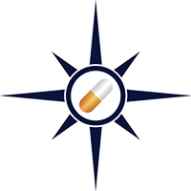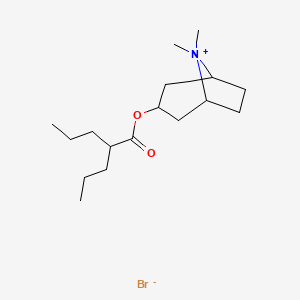



1. Anisotropine Methobromide
2. Anisotropine Methyl Bromide
3. 80-50-2
4. 8-methyltropinium Bromide 2-propylvalerate
5. Anisotropine (methobromide)
6. [(1r,5s)-8,8-dimethyl-8-azoniabicyclo[3.2.1]octan-3-yl] 2-propylpentanoate;bromide
7. Endovalpin
8. Anisotropine Methylbromide; Lytispasm; Octatropine Methylbromide; Valpin; Valpin 50; Vapin
9. Endo-8,8-dimethyl-3-((1-oxo-2-propylpentyl)oxy)-8-azoniabicyclo(3.2.1)octane Bromide
10. Octatropini Methylbromidum
11. 8-methyltropinium Bromide 2-propylpentanoate
12. Methylbromure D'octatropine
13. Metilbromuro De Octatropina
14. Schembl892570
15. Chebi:2739
16. Hms3261a20
17. Hms3371o22
18. Tox21_500409
19. Ccg-221713
20. Db00517
21. Lp00409
22. Ncgc00261094-01
23. Ft-0772217
24. 8,8-dimethyl-3-[(2-propylpentanoyl)oxy]-8-azoniabicyclo[3.2.1]octane Bromide
| Molecular Weight | 362.3 g/mol |
|---|---|
| Molecular Formula | C17H32BrNO2 |
| Hydrogen Bond Donor Count | 0 |
| Hydrogen Bond Acceptor Count | 3 |
| Rotatable Bond Count | 7 |
| Exact Mass | 361.16164 g/mol |
| Monoisotopic Mass | 361.16164 g/mol |
| Topological Polar Surface Area | 26.3 Ų |
| Heavy Atom Count | 21 |
| Formal Charge | 0 |
| Complexity | 318 |
| Isotope Atom Count | 0 |
| Defined Atom Stereocenter Count | 0 |
| Undefined Atom Stereocenter Count | 2 |
| Defined Bond Stereocenter Count | 0 |
| Undefined Bond Stereocenter Count | 0 |
| Covalently Bonded Unit Count | 2 |
Parasympatholytics
National Library of Medicine's Medical Subject Headings online file (MeSH, 1999)
...ANTIMUSCARINIC DRUG. IT APPEARS TO BE RELATIVELY SELECTIVE FOR GI TRACT... IT IS USED IN TREATMENT OF MUCOUS COLITIS & IRRITABLE COLON, SPASTIC COLITIS, SPLENIC FLEXURE SYNDROME, BILIARY DYSKINESIA, CHOLELITHIASIS, PYLOROSPASM, GASTRITIS, DUODENITIS, ENTEROCOLITIS, & PEPTIC ULCER.
Osol, A. and J.E. Hoover, et al. (eds.). Remington's Pharmaceutical Sciences. 15th ed. Easton, Pennsylvania: Mack Publishing Co., 1975., p. 849
VALPIN 50-PB INDICATED FOR USE AS ADJUNCTIVE THERAPY IN PEPTIC ULCER; IRRITABLE BOWEL SYNDROME (IRRITABLE COLON, SPASTIC COLON, MUCOUS COLITIS, ACUTE ENTEROCOLITIS, & FUNCTIONAL GI DISORDERS).
PDR; 33RD EDITION, 1979, MEDICAL ECONOMICS CO, LITTON INDUST, ORADELL, NJ 07649, 871-872
VALPIN 50-PB EFFECTIVELY PRODUCES VISCERAL SMOOTH MUSCLE RELAXATION. CONTROLS SMOOTH MUSCLE SPASM SEEN IN MOTILITY DISORDERS OF GI TRACT, SUCH AS SPASTIC COLON & FUNCTIONAL GI DISORDERS.
PDR; 33RD EDITION, 1979. MEDICAL ECONOMICS CO, LITTON INDUST, ORADELL, NJ 07649, 871-872
For more Therapeutic Uses (Complete) data for ANISOTROPINE METHYLBROMIDE (11 total), please visit the HSDB record page.
ALTHOUGH INCIDENCE & INTENSITY OF SIDE EFFECTS IS LESS THAN THOSE OF METHANTHELINE BROMIDE, THEY ARE QUALITATIVELY SAME.
Osol, A. and J.E. Hoover, et al. (eds.). Remington's Pharmaceutical Sciences. 15th ed. Easton, Pennsylvania: Mack Publishing Co., 1975., p. 849
...NO DRUG OF THIS CLASS HAS YET BEEN SHOWN TO PRODUCE ADEQUATE CONTROL OF GASTRIC SECRETION OR GI MOTILITY @ DOSES THAT ARE DEVOID OF SIGNIFICANT SIDE EFFECTS DUE TO MUSCARINIC BLOCKADE @ OTHER SITES. /QUATERNARY AMMONIUM CMPD/
Gilman, A.G., T.W. Rall, A.S. Nies and P. Taylor (eds.). Goodman and Gilman's The Pharmacological Basis of Therapeutics. 8th ed. New York, NY. Pergamon Press, 1990., p. 158
...USED WITH GREAT CAUTION, & IN SOME CASES MAY BE CONTRAINDICATED, IN PATIENTS WITH REFLUX ESOPHAGITIS, ACHALASIA, PARTIAL GASTRIC OUTLET OBSTRUCTION, PARALYTIC ILEUS, INTESTINAL OBSTRUCTION, NARROW ANGLE GLAUCOMA, & PROSTATISM. /ANTISPASMODICS/
Miller, R. R., and D. J. Greenblatt. Handbook of Drug Therapy. New York: Elsevier North Holland, 1979., p. 1041
ANTICHOLINERGIC ANTISPASMODICS SHOULD BE USED WITH CAUTION IN PATIENTS WITH PROSTATIC HYPERTROPHY, PYLORIC OBSTRUCTION, OBSTRUCTION OF BLADDER NECK, CONGESTIVE HEART FAILURE WITH TACHYCARDIA, & ACHALASIA (CARDIOSPASM). /ANTICHOLINERGIC AGENTS/
American Medical Association, Council on Drugs. AMA Drug Evaluations Annual 1994. Chicago, IL: American Medical Association, 1994., p. 935
For more Drug Warnings (Complete) data for ANISOTROPINE METHYLBROMIDE (11 total), please visit the HSDB record page.
For use in conjunction with antacids or histamine H2-receptor antagonists in the treatment of peptic ulcer, to reduce further gastric acid secretion and delay gastric emptying.
Anisotropine methylbromide is a quaternary ammonium compound. Its use as treatment adjunct in peptic ulcer has been replaced by the use of more effective agents. Depending on the dose, anisotropine methylbromide may reduce the motility and secretory activity of the gastrointestinal system, and the tone of the ureter and urinary bladder and may have a slight relaxant action on the bile ducts and gallbladder. In general, smaller doses of anisotropine methylbromide inhibit salivary and bronchial secretions, sweating, and accommodation; cause dilatation of the pupil; and increase the heart rate. Larger doses are required to decrease motility of the gastrointestinal and urinary tracts and to inhibit gastric acid secretion.
Absorption
Gastrointestinal absorption is poor and irregular. Total absorption after an oral dose is about 10 to 25%.
...POORLY & UNRELIABLY ABSORBED AFTER ORAL ADMIN... PENETRATION OF CONJUNCTIVA IS ALSO POOR, SO THAT...CMPD ARE OF LITTLE VALUE IN OPHTHALMOLOGY. CENTRAL EFFECTS ARE GENERALLY LACKING, BECAUSE THESE AGENTS DO NOT READILY PASS BLOOD-BRAIN BARRIER. ...LITTLE...KNOWN OF FATE & EXCRETION... /QUATERNARY AMMONIUM CMPD/
Gilman, A.G., T.W. Rall, A.S. Nies and P. Taylor (eds.). Goodman and Gilman's The Pharmacological Basis of Therapeutics. 8th ed. New York, NY. Pergamon Press, 1990., p. 158
WHOLE-BODY AUTORADIOGRAPHY OF MICE GIVEN SC, ORAL, OR IP DOSES OF ANTISPASMODIC, [(14)C]ANISOTROPINE METHBROMIDE SHOWED THAT PARENTERAL DOSES WERE DISTRIBUTED MAINLY IN EXCRETORY ORGANS (KIDNEYS, LIVER, SALIVARY GLANDS, & INTESTINES).
The Chemical Society. Foreign Compound Metabolism in Mammals. Volume 2: A Review of the Literature Published Between 1970 and 1971. London: The Chemical Society, 1972., p. 123
SOME (14)C /ANISOTROPINE METHBROMIDE/ WAS...PRESENT IN STOMACH MUCOSA, PANCREAS, OVIDUCTS, UTERUS, & SPERMATIC DUCTS /AFTER ADMIN TO MICE/. CATION WOULD NOT BE EXPECTED TO DIFFUSE EASILY ACROSS BIOLOGICAL MEMBRANES...DID NOT APPEAR READILY TO CROSS BLOOD-BRAIN OR PLACENTAL BARRIERS, OR GASTROINTESTINAL EPITHELIUM.
The Chemical Society. Foreign Compound Metabolism in Mammals. Volume 2: A Review of the Literature Published Between 1970 and 1971. London: The Chemical Society, 1972., p. 123
Hepatic, by enzymatic hydrolysis.
Not Known
Quaternary ammonium compounds such as anisotropine methylbromide inhibit the muscarinic actions of acetylcholine on structures innervated by postganglionic cholinergic nerves as well as on smooth muscles that respond to acetylcholine but lack cholinergic innervation. These postganglionic receptor sites are present in the autonomic effector cells of the smooth muscle, cardiac muscle, sinoatrial and atrioventricular nodes, and exocrine glands.
THERE IS CLINICAL IMPRESSION THAT QUATERNARY AMMONIUM CMPD HAVE RELATIVELY GREATER EFFECT ON GASTROINTESTINAL ACTIVITY & THAT DOSES NECESSARY TO TREAT GASTROINTESTINAL DISORDERS ARE, CONSEQUENTLY...MORE READILY TOLERATED; THIS HAS BEEN ATTRIBUTED TO ADDITIONAL ELEMENT OF GANGLIONIC BLOCK. /QUATERNARY AMMONIUM CMPD/
Gilman, A.G., T.W. Rall, A.S. Nies and P. Taylor (eds.). Goodman and Gilman's The Pharmacological Basis of Therapeutics. 8th ed. New York, NY. Pergamon Press, 1990., p. 158-9
RATIO OF GANGLIONIC BLOCKING TO ANTIMUSCARINIC ACTIVITY IS GREATER FOR CMPD WITH QUATERNARY AMMONIUM STRUCTURE BECAUSE OF THEIR GREATER POTENCY AT NICOTINIC RECEPTORS; SOME OF SIDE EFFECTS SEEN AFTER HIGH DOSES ARE DUE TO GANGLIONIC BLOCKADE. /QUATERNARY AMMONIUM CMPD/
Gilman, A.G., T.W. Rall, A.S. Nies and P. Taylor (eds.). Goodman and Gilman's The Pharmacological Basis of Therapeutics. 8th ed. New York, NY. Pergamon Press, 1990., p. 159
ANTISPASMODICS ARE COMPETITIVE ANTAGONISTS OF ACETYLCHOLINE, WHICH IS RELEASED @ ENDINGS OF PARASYMPATHETIC NERVES SUPPLYING GI TRACT. ...THESE DRUGS CAUSE MEAN REDUCTION OF BASAL ACID OUTPUT OF ABOUT 50%. THEY ALSO REDUCE MAXIMAL ACID OUTPUT BY 15 TO 50%. /ANTISPASMODICS/
Miller, R. R., and D. J. Greenblatt. Handbook of Drug Therapy. New York: Elsevier North Holland, 1979., p. 1039